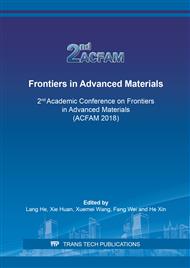[1]
Loewen E G, Shaw M C. On the analysis of cutting tool temperatures [J]. Trans. ASME, 1954, 76(2), 217-225.
DOI: 10.1115/1.4014800
Google Scholar
[2]
Yang J, Cowan R S, Winer W O. Prediction of failure transitions in sliding contacts by a thermomechanical wear model [J]. Journal of tribology, 1993, 115(3),432-438.
DOI: 10.1115/1.2921655
Google Scholar
[3]
Archard J F. The temperature of rubbing surfaces [J]. Wear, 1959, 2(6), 438-455.
DOI: 10.1016/0043-1648(59)90159-0
Google Scholar
[4]
Tian X, Kennedy F E. Contact surface temperature models for finite bodies in dry and boundary lubricated sliding [J]. Journal of tribology, 1993, 115(3), 411-418.
DOI: 10.1115/1.2921652
Google Scholar
[5]
Varadi K, Neder Z, Friedrich K. Evaluation of the real contact areas, pressure distributions and contact temperatures during sliding contact between real metal surfaces [J]. Wear, 1996, 200(1), 55-62.
DOI: 10.1016/s0043-1648(96)07269-9
Google Scholar
[6]
Sinanoglu C. Investigation of load carriage capacity of journal bearings by surface texturing. Industrial Lubrication and Tribology, 2009, 61(5), 261-270.
DOI: 10.1108/00368790910976096
Google Scholar
[7]
Etsion I. Improving tribological performance of mechanical components by laser surface texturing. Tribology letters, 2004, 17(4), 733-737.
DOI: 10.1007/s11249-004-8081-1
Google Scholar
[8]
Tønder K. A new class of bearings, based on roughness effects [C]//STLE/ASME Tribology Conference, Orlando, FL, USA. (1999).
Google Scholar
[9]
Blok H. Surface temperature measurements on gear teeth under extreme pressure lubricating condition [J]. Proceedings of the Institution of Mechanical Engineers, 1937, 2, 14-20.
Google Scholar
[10]
Jaeger J C. Moving sources of heat and the temperature of sliding contacts [C]//J. and Proc. Roy. Soc. New South Wales. 1942, 76, 202.
Google Scholar
[11]
Pettersson U, Jacobson S. Influence of surface texture on boundary lubricated sliding contacts [J]. Tribology International, 2003, 36(11), 857-864.
DOI: 10.1016/s0301-679x(03)00104-x
Google Scholar
[12]
Ling F F. A quasi-iterative method for computing interface temperature distributions [J]. Zeitschrift für angewandte Mathematik und Physik ZAMP, 1959, 10(5), 461-474.
DOI: 10.1007/bf01601355
Google Scholar
[13]
Brizmer V, Kligerman Y, Etsion I. A laser surface textured parallel thrust bearing [J]. Tribology Transactions, 2003, 46(3), 397-403.
DOI: 10.1080/10402000308982643
Google Scholar
[14]
Etsion I, Halperin G. A laser surface textured hydrostatic mechanical seal [J]. Tribology Transactions, 2002, 45(3), 430-434.
DOI: 10.1080/10402000208982570
Google Scholar
[15]
Feldman Y, Kligerman Y, Etsion I. A hydrostatic laser surface textured gas seal [J]. Tribology letters, 2006, 22(1), 21-28.
DOI: 10.1007/s11249-006-9066-z
Google Scholar
[16]
Wang X, Kato K, Adachi K, et al. Loads carrying capacity map for the surface texture design of SiC thrust bearing sliding in water [J]. Tribology International, 2003, 36(3), 189-197.
DOI: 10.1016/s0301-679x(02)00145-7
Google Scholar
[17]
Blok H. Theoretical study of temperature rise at surfaces of actual contact under oiliness lubricating conditions[C]//Proceedings of the general discussion on lubrication and lubricants. London, IMechE, 1937, 2, 222-235.
Google Scholar


